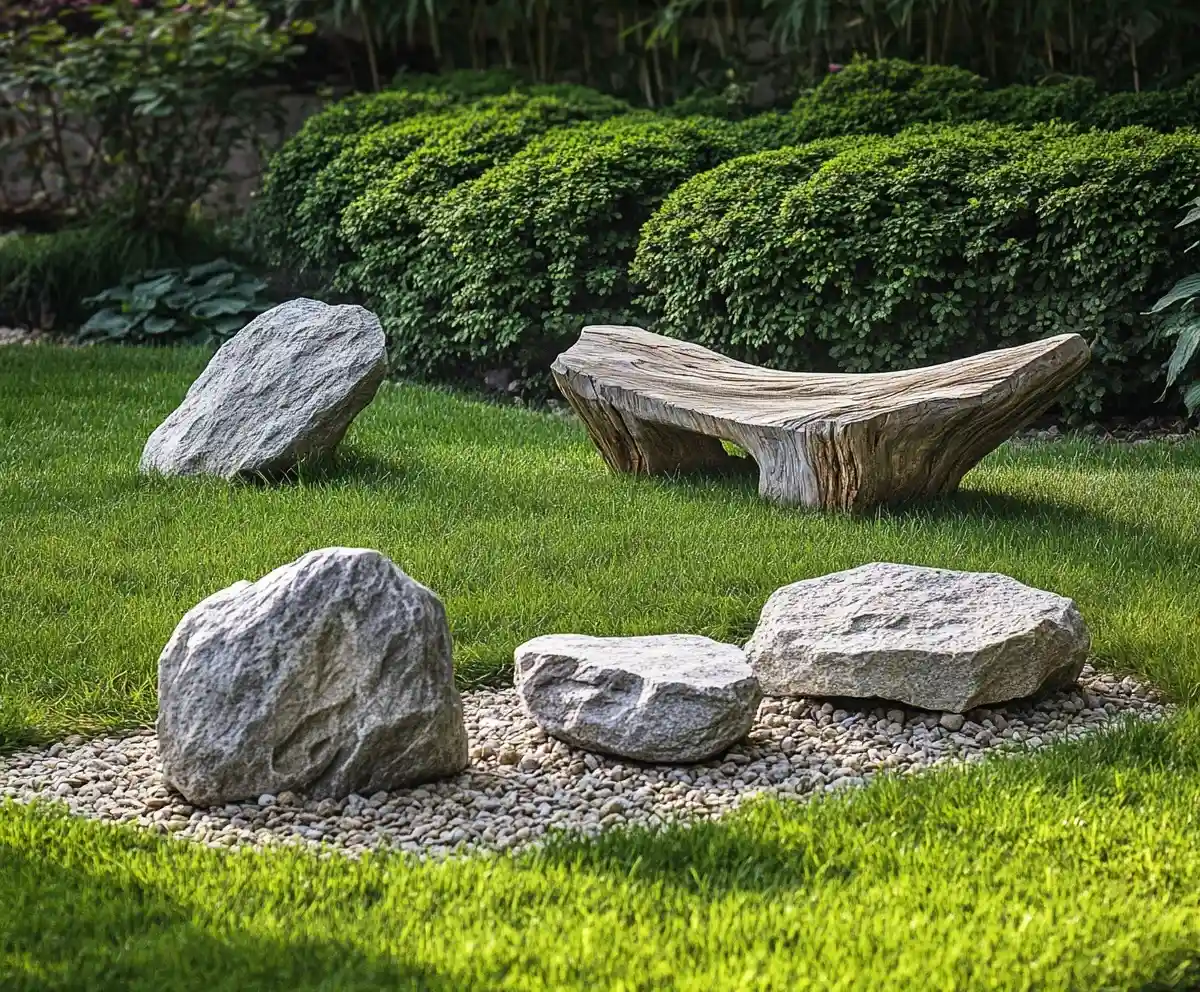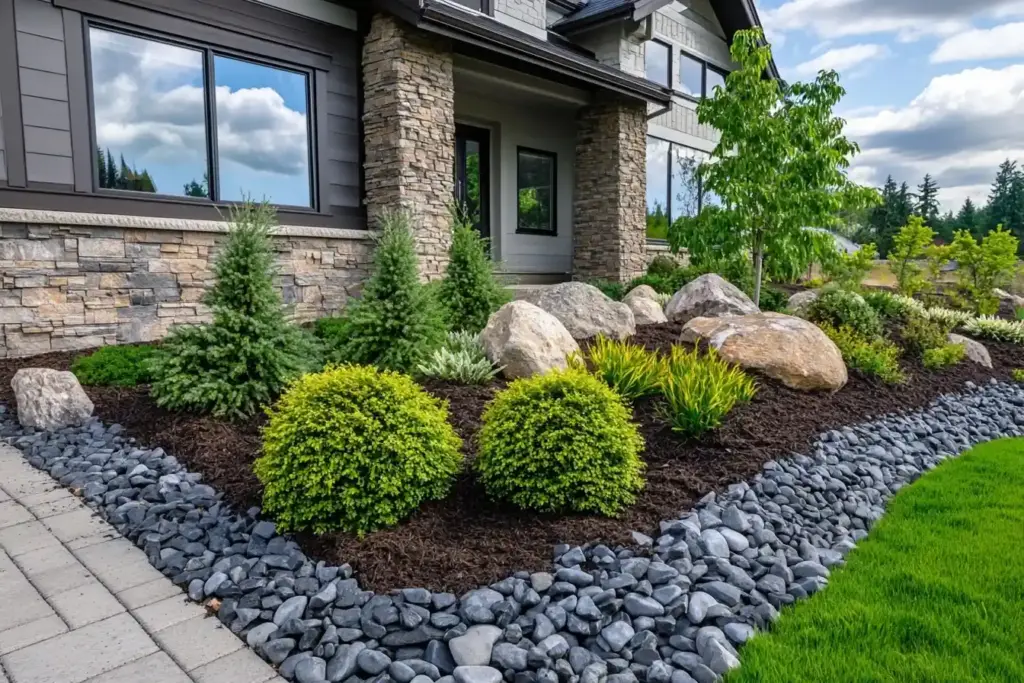Landscaping with boulders is a lasting, low-maintenance way to add structure and beauty to your yard. Whether you’re upgrading your front yard or adding a rugged touch to the backyard, boulders bring texture and a natural feel without the upkeep of traditional plants.
They pair perfectly with drought-tolerant plants and are ideal for low-maintenance landscaping. From rock garden ideas to stone pathways, these elements offer timeless appeal with minimal effort.
🌿 Love gardening inspiration? Follow me on Pinterest for bold plant ideas, tips, and seasonal color!
Table of Contents
1. Spruce Up Your Front Yard
If you’re looking for a low-maintenance way to add visual interest to your home’s curb appeal, landscaping with boulders is an excellent choice. These large stones can anchor flower beds, frame entryways, or complement shrubs and ornamental grasses.
Choose boulders in different tones and textures to break up the monotony of flat flowerbeds. A few well-placed stones can add contrast, drawing the eye across the yard. Mix in plants of varying heights around the boulders—such as lavender, dwarf fountain grass, or creeping thyme—to create a balanced, layered look.
Keep proportions in mind: in smaller yards, one or two medium-sized boulders may be enough to make an impact without crowding the space.
2. Showcase a Boulder
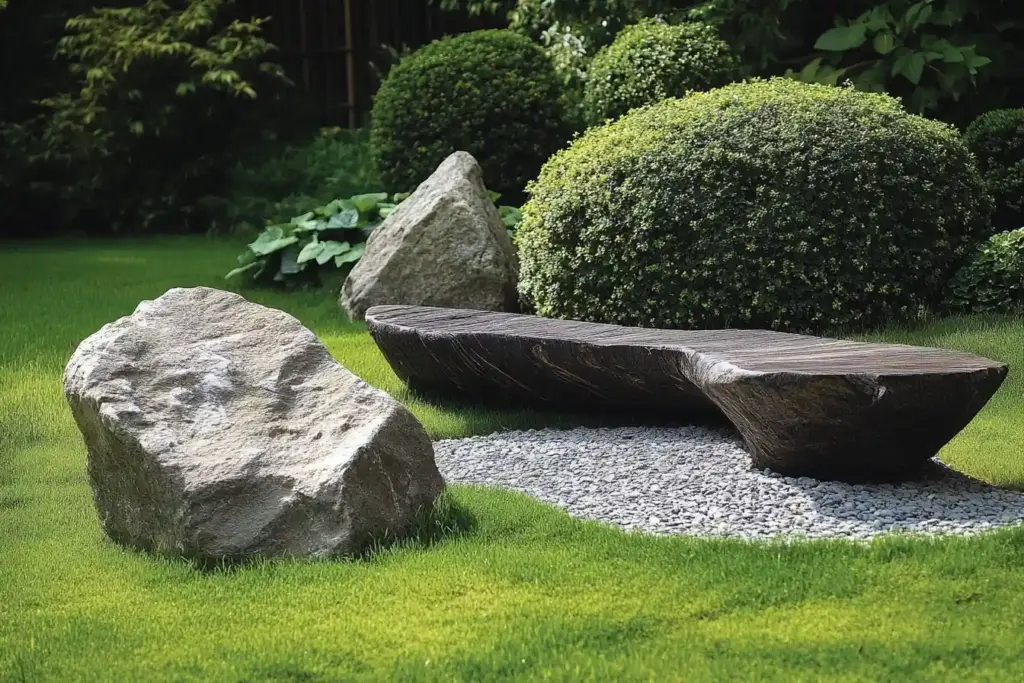
Sometimes, less is more—especially when it comes to landscaping with boulders. Highlighting a single, striking boulder as a natural focal point can bring a quiet elegance to your garden design. Look for a stone with an interesting shape, surface texture, or coloration that naturally stands out.
Place it in a visible but neutral area of your yard, such as at the curve of a path, at the center of a low flower bed, or framed by ornamental grasses. Surround it with low-growing plants like blue fescue or sedum to let the boulder remain the star of the show.
If the stone has a flat or slightly angled surface, position it upright or on its edge to create a sculptural look—almost like nature’s own art installation.
3. Build Steps
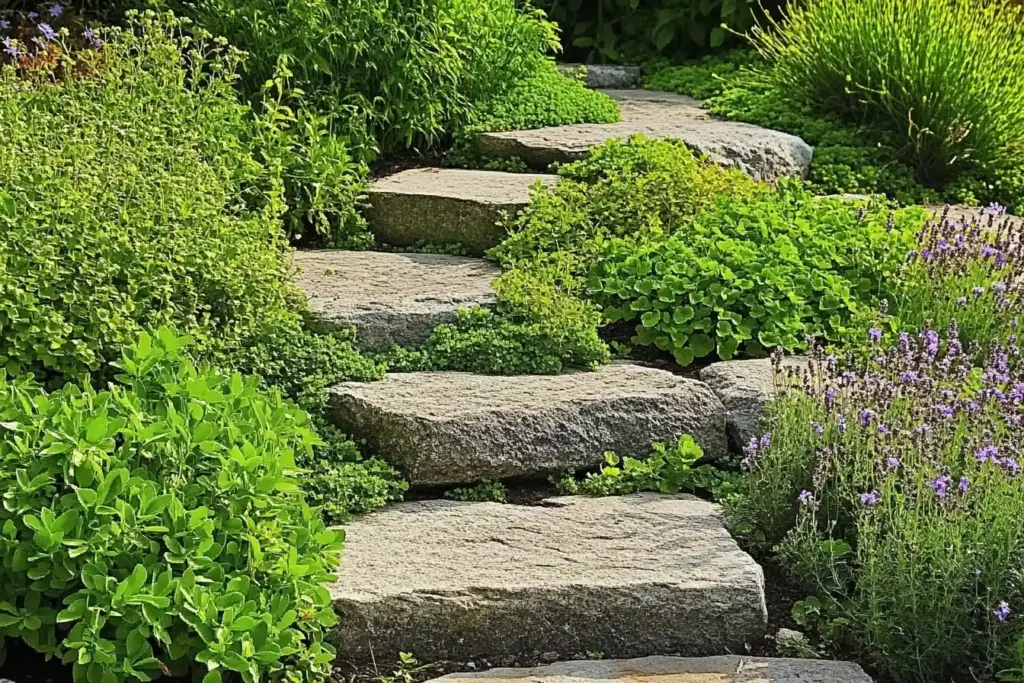
When your landscape includes a slope or elevation change, landscaping with boulders offers a functional and eye-catching solution: natural stone steps. Unlike uniform concrete or brick, boulder steps bring organic charm and rustic appeal to sloped gardens or hillside yards.
Select flat-faced boulders or large stepping stones that are wide and stable enough to walk on comfortably. Start with the largest stones at the bottom to create a solid foundation, then gradually layer upward, making sure each step is level and secure.
To enhance the natural feel, edge the steps with hardy groundcovers like creeping Jenny or moss, or tuck small plants between gaps for a soft, lived-in look. These stone steps can lead to a patio, garden bed, or simply create a natural trail through your yard.
4. Add a Water Feature
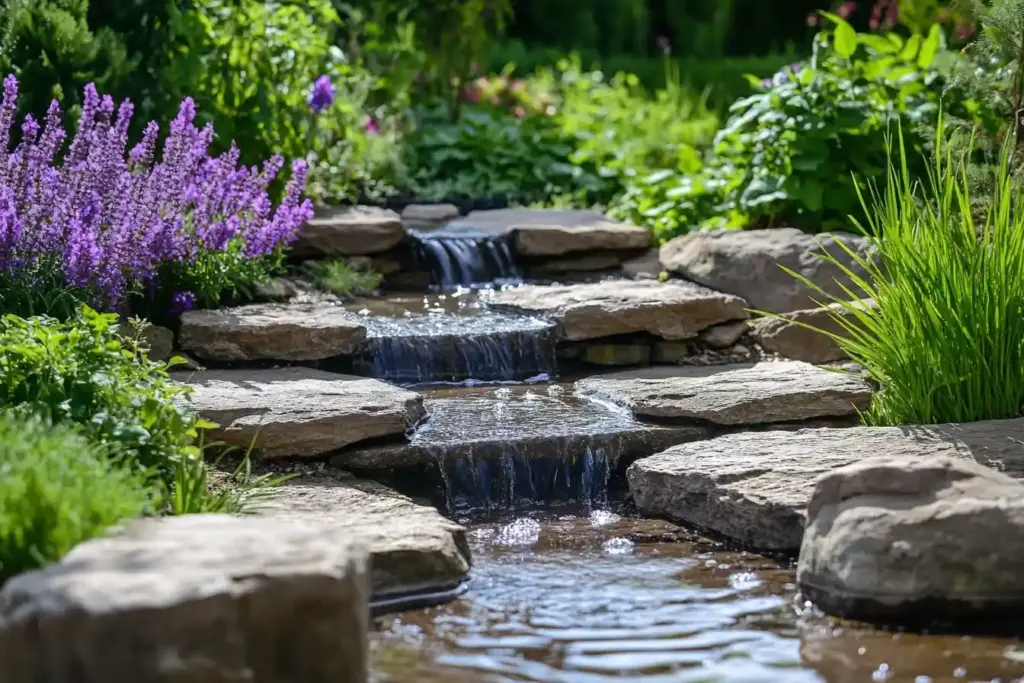
One of the most serene and impactful ways to use landscaping with boulders is by incorporating them into a water feature. Whether it’s a bubbling rock fountain, a cascading stream, or a tranquil pond, boulders help shape and define the water’s path while giving the space a grounded, natural look.
Position larger boulders around the water source to act as structural anchors, then layer in smaller stones and gravel to soften the edges. This combination mimics the look of a natural creek bed and helps blend the feature into your overall landscape.
For added beauty, plant moisture-loving species like Japanese iris, hostas, or creeping jenny along the water’s edge. And if you want to enjoy the peaceful ambiance after dark, install warm LED lighting to illuminate the boulders and reflect off the water’s surface.
5. Create Rock Garden
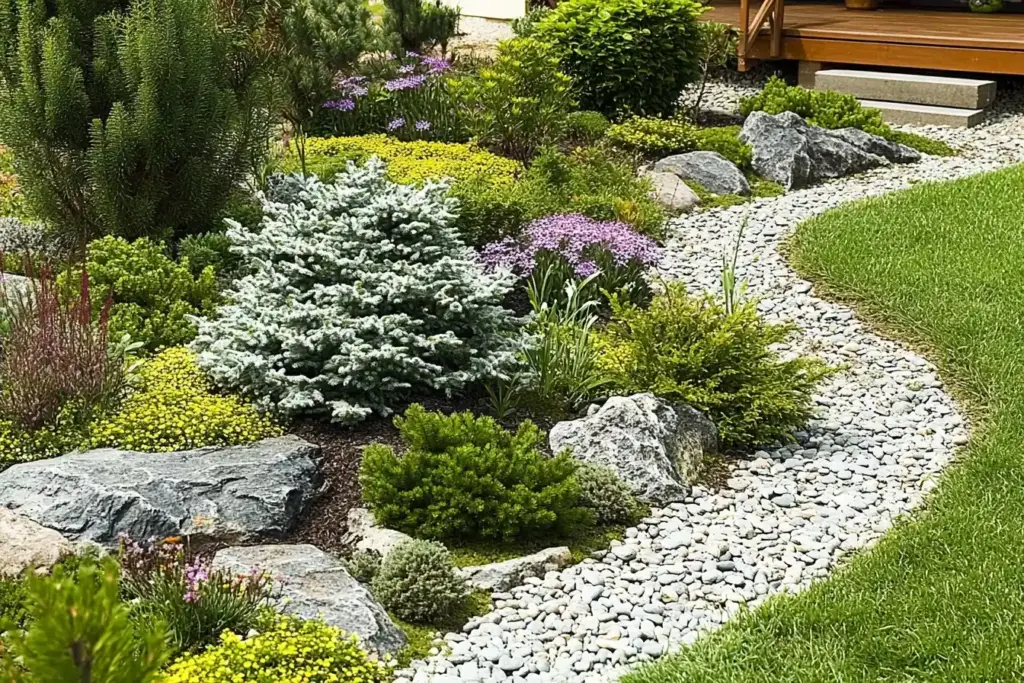
A thoughtfully designed rock garden brings texture, color, and a sense of tranquility to your yard—especially when you incorporate landscaping with boulders as a central element. Boulders act as natural anchors that structure the space and create visual flow.
Start by selecting drought-tolerant plants like succulents, alpine species, or ornamental grasses that thrive in rocky, well-drained soil. Position the boulders in a way that mimics nature—angled, partly buried, and irregularly spaced—to avoid a forced or artificial look.
Fill in the gaps with crushed gravel or small river stones, which help control weeds and maintain a tidy appearance. Consider adding height variation with mounded soil or layered plantings around the rocks to give your garden depth and a more immersive feel.
This style is perfect for dry climates or anyone seeking a beautiful, low-maintenance alternative to traditional lawns.
6. Build Retaining Wall
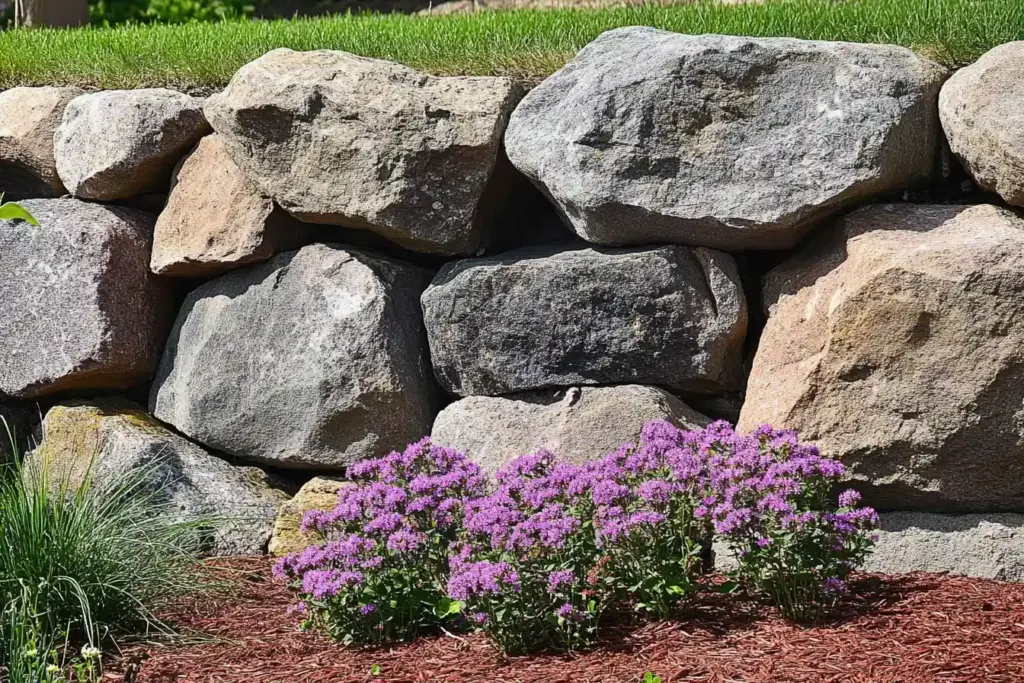
If your yard has sloped or uneven ground, landscaping with boulders can solve practical issues while adding rustic charm. A boulder retaining wall helps control soil erosion, define spaces, and create terraced planting areas—without relying on synthetic materials.
To build a durable and natural-looking wall, start with the largest boulders at the base. These anchor the structure and provide support. Stack medium and smaller stones on top, fitting them together like a natural puzzle. Leave slight gaps for drainage and plant low-maintenance greenery, like creeping thyme or sedum, between stones to soften the edges.
Unlike traditional block walls, a boulder wall doesn’t need to be perfect or symmetrical. Its irregular look is part of the appeal, giving your yard a timeless, weathered aesthetic that blends seamlessly with nature.
7. Group Boulders Together
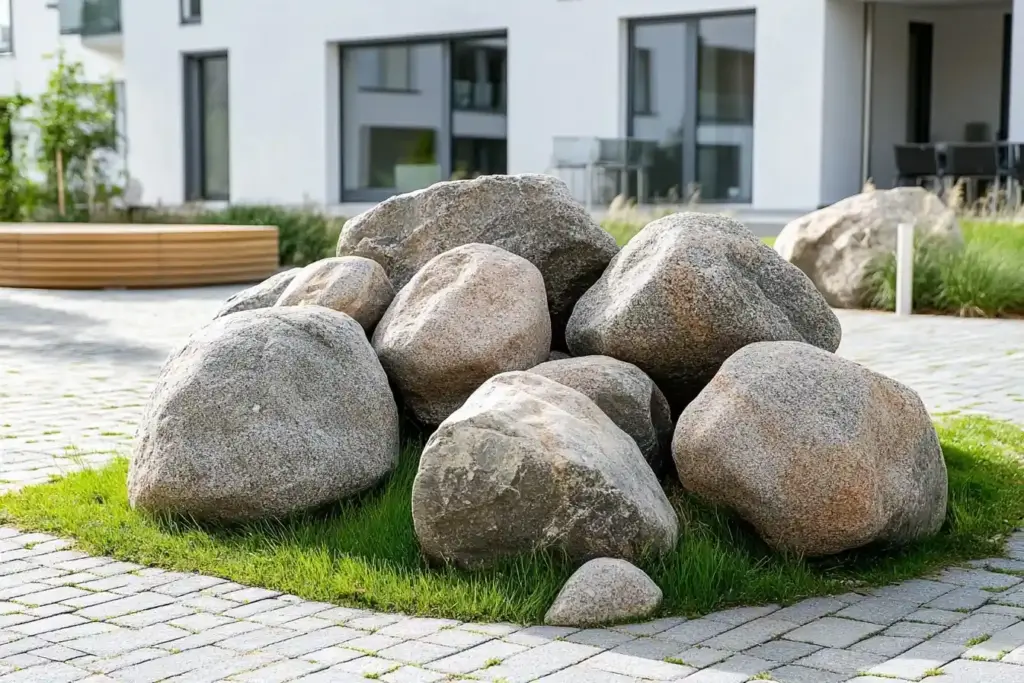
While a single boulder can make a statement, landscaping with boulders becomes even more visually compelling when you group them. Clustering two or three stones of different sizes mimics natural rock formations and brings depth and character to flat or minimal areas of your yard.
Aim for an odd number of boulders and vary their placement—some slightly buried, others angled—to avoid a uniform, artificial look. Groupings work well in corners of flower beds, at the base of trees, or to frame walkways.
To enhance the effect, surround the boulders with ornamental grasses or evergreen shrubs that contrast in texture and color. The goal is to make it appear as though the rocks have always been part of the landscape, not just placed there.
This method works especially well in larger spaces where a single rock might feel lost or underwhelming.
8. Use Boulders As Stepping Stones
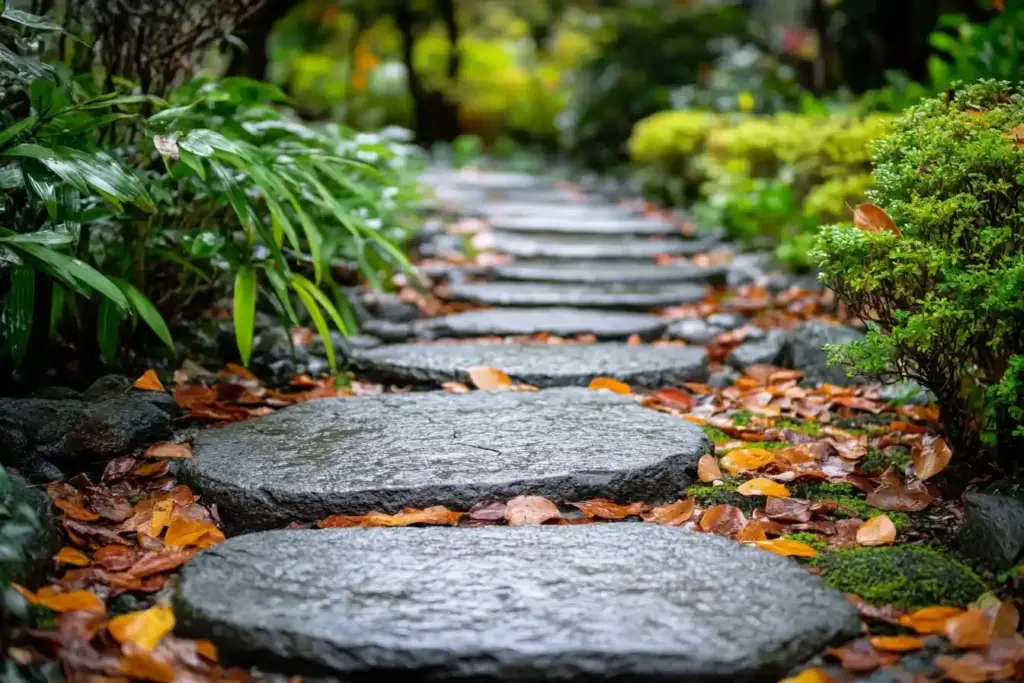
Turn practical paths into charming features by landscaping with boulders as oversized stepping stones. This natural approach not only guides foot traffic through your garden but also adds texture and interest to the landscape.
Choose flat-topped boulders with a stable surface, ideally spaced 18–24 inches apart for comfortable walking. You can embed them slightly into the soil for a level, secure feel underfoot. This technique works beautifully through lawns, gravel beds, or even alongside ponds and flower borders.
To tie the path into the overall design, flank it with low-growing plants like creeping thyme, mondo grass, or dwarf sedum. These soft, spreading plants thrive in the crevices and help the path blend naturally into the surrounding garden.
Paths made with boulder stepping stones feel organic and timeless—ideal for both rustic and modern garden styles.
9. Put an Accent On The Boulders With Garden Lights

Adding lighting is one of the most impactful ways to elevate landscaping with boulders, especially at night. With the right illumination, boulders transform from passive elements into sculptural highlights that anchor your outdoor space even after the sun goes down.
Use low-voltage LED spotlights or in-ground lights to cast gentle beams across the surface of the stones. Position lights to graze the texture of the rock, revealing shadows and contours that give depth and drama. Uplighting is especially effective for large or vertical boulders, while side lighting works well for clusters.
To soften the effect, you can filter light through ornamental grasses or leafy plants nearby. This adds movement and complexity to the shadows, creating a natural, serene atmosphere.
Not only does this enhance safety and visibility, but it also brings a warm, inviting glow to your garden during evening hours.
10. Create an Alpine Garden With Colorful Flowers
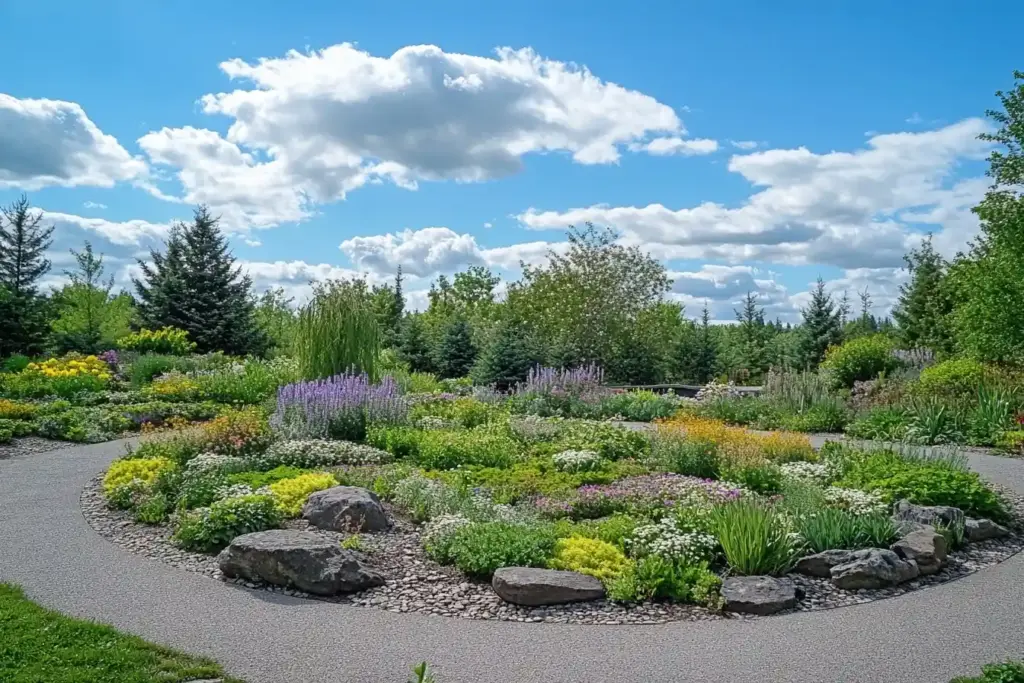
Blending hardy plants with rugged stones, an alpine garden is a striking way to use landscaping with boulders for both beauty and resilience. This style thrives in well-drained soil and mimics mountain terrain, where flowers peek between rocks in vibrant contrast.
Begin by partially embedding your boulders into mounded soil to replicate a natural hillside. Then plant low-growing alpine favorites like aubrieta, saxifrage, dianthus, or dwarf phlox around the stones. These varieties not only thrive in rocky conditions but also spill beautifully over edges, softening the bold look of the boulders.
Use a mix of leaf textures and bloom times to ensure year-round interest. Small evergreens and sedums can add structure in winter, while spring and summer bring bursts of color.
This type of garden is perfect for dry, sunny spots and requires minimal watering—offering a colorful, low-maintenance solution packed with charm.
11. Use Boulders In Your Patio Design
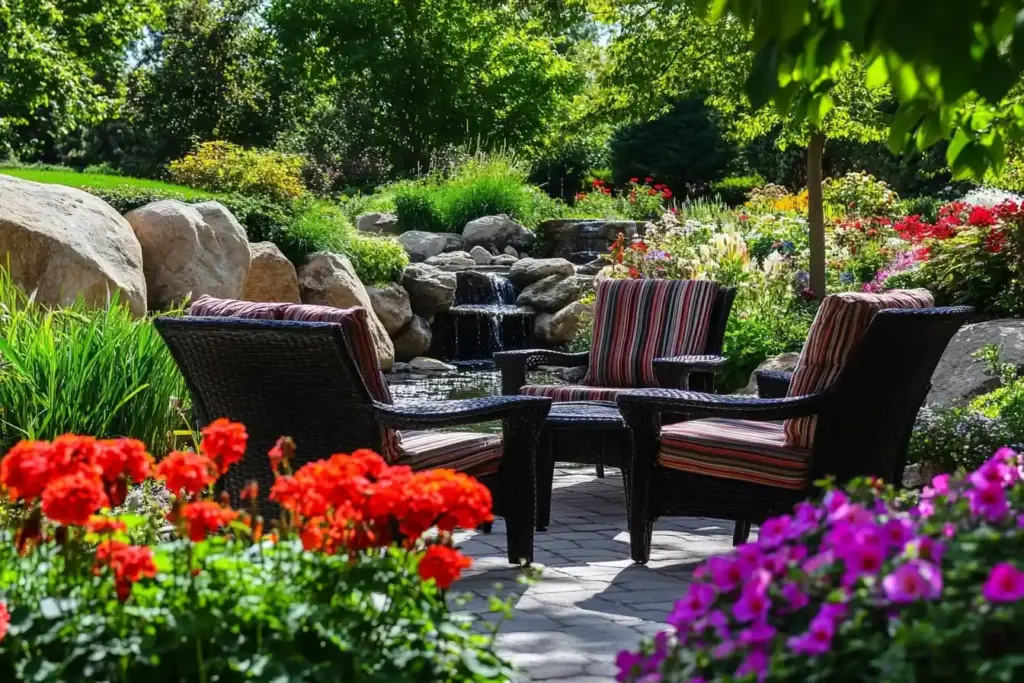
Incorporating landscaping with boulders into your patio design adds a grounded, earthy feel that enhances both form and function. Boulders can define the edges of a seating area, act as informal benches, or even break up hardscape lines with a more organic touch.
Start by placing boulders along the perimeter of your patio to create soft boundaries. Choose stones that contrast with your paving material—for example, pairing cool gray flagstone with warm, weathered granite. This contrast adds visual interest while maintaining harmony in the space.
Larger boulders can double as natural seats or table bases, especially in casual or rustic-themed outdoor areas. To soften the look, plant creeping herbs like oregano or woolly thyme between the stones or in gaps near the patio edges.
Using boulders this way helps blend your patio into the surrounding landscape while adding lasting beauty and durability.
12. Add Texture and Height To Your Front Yard
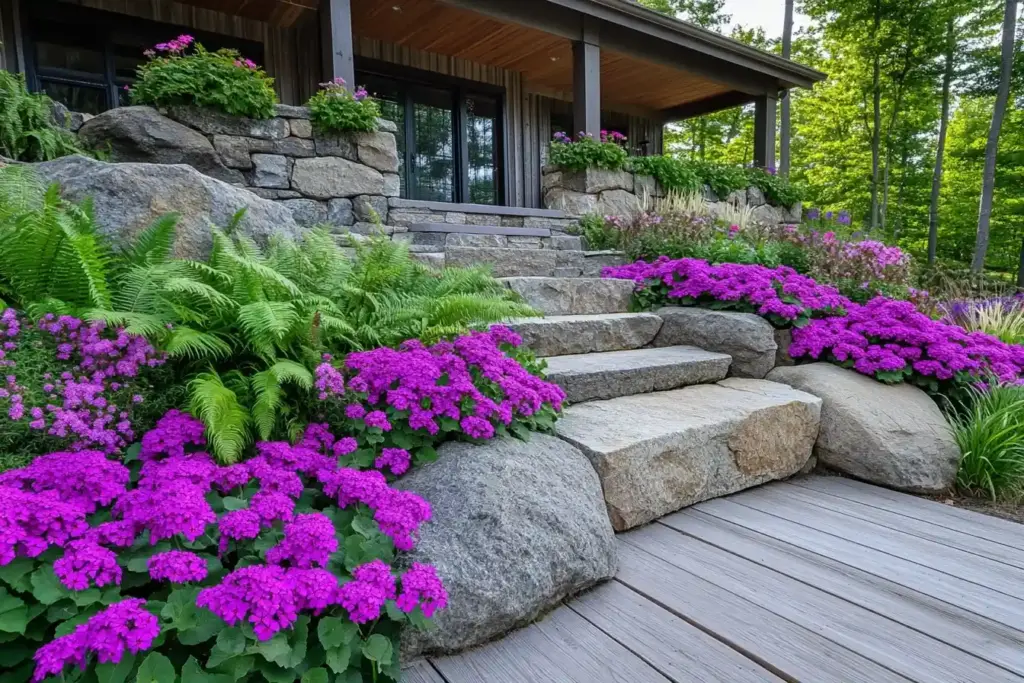
If your front yard feels flat or sparse, landscaping with boulders is a simple yet powerful way to introduce both vertical interest and visual texture. Unlike plants that change with the seasons, boulders provide year-round structure that anchors your design.
Use a mix of stone sizes to create a layered effect—placing larger boulders toward the back of a bed and smaller ones closer to the front. This not only builds depth but also draws the eye upward, making your space feel fuller and more dynamic.
Pair taller boulders with upright plants like ornamental grasses, yucca, or columnar evergreens to amplify height without crowding. You can also cluster smaller stones around a larger one to mimic natural outcroppings and enhance realism.
By combining height, shape, and texture, your yard will feel more curated and lively—without adding extra maintenance.
13. Surround Boulders With Pebbles or Gravel
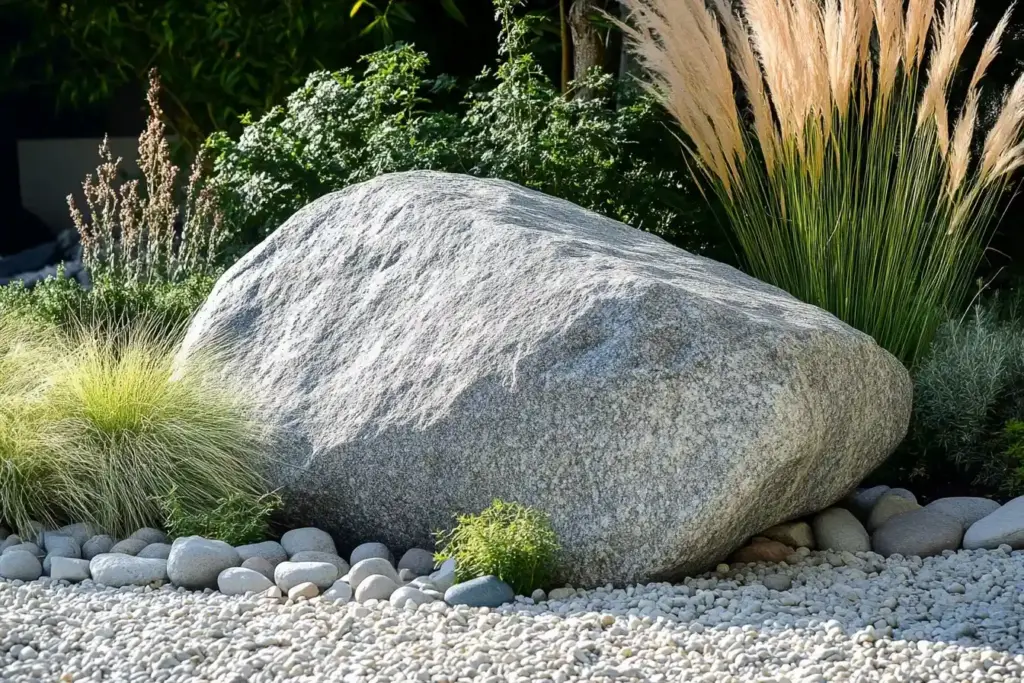
To give your garden a polished and cohesive look, consider landscaping with boulders surrounded by pebbles or gravel. This technique highlights the boulders as focal points while helping to suppress weeds and manage water drainage.
Choose complementary gravel tones—like warm beige, cool gray, or mixed river rock—to contrast with the color of your boulders. Spread the gravel around the base of each stone, tapering it out naturally into the surrounding landscape. This frames the boulders visually and creates a seamless transition between rock and soil.
In larger areas, raked gravel can be used to form patterns like waves or spirals for a Zen-inspired aesthetic. In tighter spaces, finer gravel provides a clean, tidy finish that doesn’t compete with nearby plantings.
This design element not only enhances your boulders but also keeps the garden low-maintenance and well-drained year-round.
Conclusion
Landscaping with boulders goes far beyond simply placing rocks in your yard—it’s about shaping a harmonious, nature-inspired space that looks incredible and requires minimal upkeep. Whether you’re defining the edge of a relaxed patio space or building out a peaceful rock garden, boulders offer lasting structure and creative freedom. Their rugged charm works beautifully with surrounding greenery, garden lighting, and natural materials.
For yards with slopes, boulders are ideal for crafting budget-friendly hillside landscaping solutions that are both functional and beautiful. And when paired with drought-resistant flowers or ornamental grasses, they form a cohesive landscape that looks polished and natural.
With thoughtful placement and the right complementary elements, you can turn your garden into a welcoming, grounded space that thrives across all seasons—low effort, high reward.
FAQ
How do I choose the right boulders for my yard?
Start by considering the scale of your space. Large, dramatic boulders work well in open areas, while smaller or mid-sized stones are ideal for tighter landscapes. Look for natural color tones that complement your home’s exterior and existing garden features. When possible, select boulders from local quarries—they’ll blend more naturally with your environment and often cost less to transport.
Should boulders be buried in the ground?
Yes, at least partially. Burying about one-third of a boulder’s height gives it a more natural appearance and prevents it from shifting over time. This approach mimics how rocks appear in nature and helps anchor them visually into the landscape.
Can I install boulders myself, or do I need professional help?
It depends on the size and quantity. Small to medium-sized boulders can often be moved with a wheelbarrow or dolly, especially with a helper. Larger stones typically require machinery and expertise to place safely and securely. For big projects, it’s wise to consult a landscaper or contractor.
What plants work well around boulders?
Choose plants that thrive in well-drained soil and match your region’s climate. Good options include creeping thyme, sedum, blue fescue, lamb’s ear, and dwarf ornamental grasses. In shaded areas, ferns and hostas pair beautifully with stones. Always consider scale—low growers often look best around large boulders.

